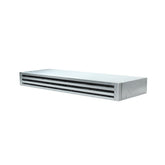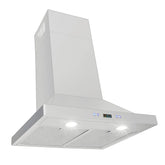During the summer, it’s a lot of fun to host gatherings on your outdoor patio. Or if you just need a place to relax, the patio is perfect. But depending on where you live, it won’t always be warm. Maybe it gets cold late into the night but you want to keep your guests comfortable.
You come across patio heaters but aren’t sure about their safety measures. Can you use a patio heater under a covered patio?
Yes, but the patio heater should be several feet away from combustible materials and structures. Keep patio heaters away from wood beams and posts to reduce the risk of fire. Follow the manufacturer’s instructions to keep you and your guests safe.
Gas and propane patio heaters are built for outdoor use and thus should not be used indoors. Only use these patio heaters in open outdoor areas where you have adequate ventilation. They produce harmful VOCs like carbon monoxide that can be dangerous to your health in large quantities.
Electric patio heaters can be used indoors. But it’s always important to keep your heater away from combustible materials. Be sure to follow the manufacturer’s instructions when operating your electric patio heater.
Be careful when using patio heaters at high altitudes. Most patio heaters are designed to be run at sea level. They won’t work effectively at high altitudes since there’s less oxygen in the air. The air is less dense so the patio heater will take longer to heat up.
Also, most patio heaters are only meant for a few hours of use. The time may vary depending on the specific product. Keep in mind that outdoor-rated does not mean indestructible. Leaving your patio heater on overnight or longer is a fire hazard.
8 Things to Consider When Buying Patio Heaters

Ventilation
One of the most important things to consider is the ventilation in your patio. If the space is poorly ventilated, you should avoid gas or propane heaters. Harmful contaminants can build up which is dangerous to your health. Indoor electric heaters will be your best bet.
To improve ventilation, start by opening doors and windows. You can point a fan to the outside to help funnel some of the air to your backyard too.
If you’re an avid cook, consider investing in a professional outdoor range hood for your patio. It will keep cooking smells, smoke, and harmful contaminants out of your patio area.
Portable or permanent?
Do you want a portable or permanent patio heater? Think about where your guests will spend most of their time. If you have a larger open area, a permanent heater may be a good choice. Also, if you spend a lot of time with your guests on the patio, a permanent heater is the way to go.
But if your patio is split into sections, you might want a portable heater. That way guests can move them around as they go from place to place. Or if you don’t use your patio often, a permanent heater may not be worth the investment.
Safety - Kids and Pets
Keep your patio heater out of range of pets and children. Patio heaters can get incredibly hot to the touch! Tell your kids about the heater and keep pets out of the area when the heater is running.
Halogen lights typically get much hotter than LEDs. But consult the manufacturer to learn more about your specific heater.
Clearance
The clearance describes how many feet your patio heater needs to be clear of combustibles and wooden structures. Typically, the larger and more powerful the heater, the more clearance you’ll need. Avoid crowding your patio heater for the safest and most comfortable experience.
Every patio heater is different, so consult the manufacturer’s instructions to determine the exact clearance you need. Don’t skip this step – without enough clearance, patio heaters are a fire hazard! If in doubt, leave extra distance between any objects and the patio heater.
BTUs
The British Thermal Units (BTUs) of your patio heater depend on the size of your patio. Take the square footage of your patio and multiply it by 20 to get the approximate BTUs you’ll need for your heater. Also, pay close attention to the product description. It may specify the best areas for the patio heater – or even the square footage.
Quantity
Depending on your patio setup, you might need multiple heaters to keep the space nice and warm. Only buy multiple heaters if you need the areas warmed up simultaneously. Otherwise, you can invest in a portable heater. When you move to a different area of your patio, take the heater with you.
Type
Three common types of patio heaters are electric, natural gas, and propane. Electric patio heaters are great for enclosed areas as they don’t produce any VOCs. Gas and propane require some ventilation to operate safely. But they are a valuable investment for your patio.
Natural gas heaters will need to be hooked up to your gas line so you may be limited in where you can place them. Propane heaters get gas from a propane tank just like a propane grill. Electric patio heaters don’t require gas but you’ll need to run power to them.
Cost
Most patio heaters range between $100 and $300. Choose a reputable brand and check the product reviews to make sure you’re getting great value out of your purchase. A patio heater is a long-term investment that can last several years if maintained well.
Natural gas is cheaper than propane to operate. A propane patio heater will last between 10 and 20 hours on a 20-pound propane tank before you need to buy a replacement tank. Natural gas, on the other hand, does not need to be resupplied.
Electric heaters are the cheapest of the three types of patio heaters. They don’t require gas so you save a little on your utility bill.
Frequently Asked Questions
Can you use a gas patio heater under a covered patio?
Yes, you can use a gas patio heater under a covered patio. Just make sure that there’s nothing flammable within a few feet of the heater. Check the manufacturer’s instructions for the exact range. Don’t place the gas heater near any wooden beams or you could cause a fire.
Can you use a propane patio heater under a covered patio?
Yes, you can use a propane patio heater under a covered patio. Leave at least a few feet of empty space around the heater to reduce the risk of a fire. Check the manufacturer’s instructions to be safe. Don’t place the propane heater or propane tank near any wooden beams or you could cause a fire.
Can you use an electric patio heater under a covered patio?
Yes, you can use an electric patio heater under a covered patio. Most electric heaters are safe for indoor use too. Consult the manufacturer’s instructions for specific information.
Can you use a patio heater under a screened porch?
In an enclosed area like a screened-in porch, it’s best to use an electric heater. You likely won’t have adequate ventilation with a gas or propane patio heater.
Can you use a patio heater indoors?
You can use an electric patio heater indoors. Keep it away from any water to reduce the risk of shock. Do not use gas or propane patio heaters indoors because they produce VOCs that are dangerous to your health.
Can you use a gas patio heater indoors?
Do not use a gas patio heater indoors under any circumstances. Burning natural gas produces formaldehyde, carbon monoxide, and other dangerous compounds. These can accumulate quickly indoors which is harmful to you and your family’s health.
Can you use a propane patio heater indoors?
No, do not use a propane patio heater indoors. Not only does propane produce harmful compounds, but the tank is also highly flammable. You run a high risk of starting a fire in your home. Electric heaters are the best type for indoor use.
Can you use an electric patio heater indoors?
Yes, electric patio heaters are a great option for indoor use. Keep it away from water to reduce the risk of shock. Avoid putting any combustible materials within a few feet of the heater.
Can you use a patio heater in the garage?
Avoid using your patio heater in the garage. Carbon monoxide, nitrogen oxide, and other contaminants accumulate inside, which are dangerous for your health. Electric patio heaters are designed for indoor use but are not recommended in tight areas like garages.
Can you use a patio heater in the garage with the door open?
It’s possible, but not recommended to use a patio heater in a garage with the door open. You will improve ventilation, but you still run the risk of a fire. Consult the manufacturer’s instructions to learn about how and where to safely use your patio heater.
Can you use a patio heater under a canopy?
Yes, you can use a patio heater under a canopy. Make sure the canopy ceiling is a few feet above the patio heater to reduce the risk of fire. Keep all combustibles away from the patio heater and don’t put it close to any wooden posts.
Make sure to buy a heater that’s the appropriate size. A large patio heater in a small area is a fire hazard.
We hope you found your answer to the question ‘Can you use a patio heater under a covered patio?’ Remember to read the manufacturer’s instructions thoroughly before using your patio heater under a covered patio.
Good luck finding the right patio heater for your home. For more outdoor patio content, check out the articles below.
Related Articles
How to Plan a Patio (11 Helpful Tips)
7 Practical Patio Furniture Ideas












